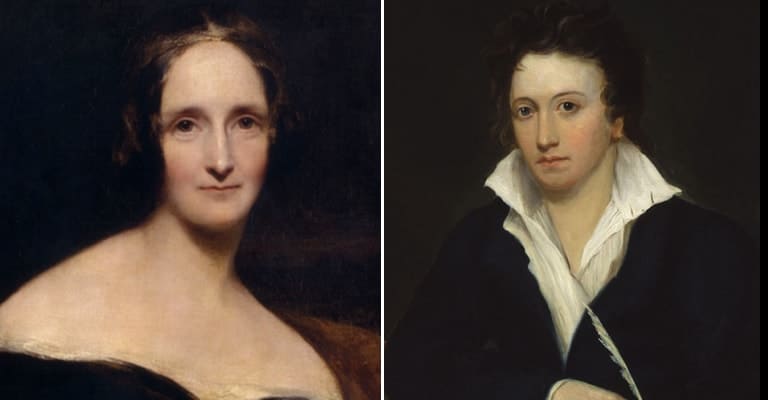A year after her death, Mary Shelley’s son, Sir Percy Shelley, finally opened his mother’s writing desk. The desk had been an important part of Mary’s daily life- in more ways than one, as Sir Percy was to discover. For inside, he found, not Mary’s last works but a reliquary of Mary’s past. Locks of his dead brother and sister’s hair mingled with the notebooks Mary had shared with her long-dead husband, the poet Shelley. Fragments of Shelley’s poems also resided amongst these mementos of Mary’s married life- along with something else. For, wrapped in the pages of his father’s poem, Adonais, Sir Percy came across a silk bag. Sir Percy unwrapped it, to reveal the charred remains of Shelley’s heart.
Edward Trelawny had rescued the heart from Shelley’s funeral pyre on an Italian beach thirty years earlier. Mary had to fight to reclaim it from those who felt they had a better claim to Shelley’s love. However, once it was within her grasp, she must have been comforted knowing that, even if she had not always exclusively possessed Shelley’s heart in life, she did so in death. However, aside from the question of why someone would want to keep such a grizzly relic of a loved one is another one: was the object in Mary’s writing desk Shelley’s heart at all?

The Death of Shelley
On July 8, 1822, Percy Shelley set off in his boat the Don Juan on the return journey to his home in Lerici after a weeklong visit to his friends Leigh and Marianna Hunt and Lord Byron. The day of the 8th dawned clear and oppressively hot. Despite this, Captain Roberts, the skipper of the Don Juan, detected storm clouds on the horizon. So, he warned against the journey. Shelley and his friend Edward Williams, however, were eager to return to Mary Shelley, Jane Williams, and their children. So, leaving Roberts behind, at 2 pm they set sail in the company of Charles Vivien, the ship’s boy.
The last reported sighting of the Don Juan was by Italian fishermen who spotted the craft struggling against the storm that did indeed blow up in the Bay of Spezia that afternoon. Edward Trelawny immediately began searching the coast for remains. Ten days after the Don Juan’s disappearance, the bodies began to turn up. Shelley was found on a beach near Via Reggio. Trelawny only knew him from his clothing, and a book of Keats’s poems in his pocket as his “face and hands and parts of the body not protected by dress were fleshless.” Williams, found three miles away, could only be identified by a monogrammed necktie and his boots. The remains attributed to Charles Vivien were found three weeks later.
Italian burial regulations dictated the bodies had to be buried immediately. So, Trelawny, Leigh Hunt, and Byron temporarily buried Shelley and Williams in quicklime on their respective beaches while they decided on a more permanent solution. They chose cremation. So, Trelawny had a portable iron crematorium made in nearby Leghorn. Williams was cremated on August 15th. Then on the 16th, it was Shelley’s turn.
As Shelley’s body was disinterred, a mattock hit his head, splitting the skull. This damage did not help the unpleasant appearance of the corpse, which was now also indigo from the quicklime. However, the funeral party, consisting of Trelawny, Leigh Hunt, Byron, members of the Italian militia and a few local fishermen, could confer it, intact to its iron funeral pyre. There, Shelley was given as near a classical send-off as his friends could manage. Oil and salt were added to the wood and “more wine was poured over Shelley’s body than he had consumed during his life.”

According to Trelawny, the fire was ‘so fierce as to produce a white heat on the iron and reduce its contents to grey ashes.” Shelley’s exposed brains “seethed, bubbled and boiled” and “‘the corpse fell open, and the heart was laid bare.” At this grizzly sight, Lord Byron could bear no more and went for a swim while Hunt stayed in the carriage. Trelawny stayed to witness all that had been Shelley reduced to ash and “some fragments of bones, the jaw and the skull,” However, Shelley’s “heart remained entire.” Astonished, Trelawny snatched the heart from the flames, burning his hand. Shelley’s ashes were gathered and buried in the Protestant cemetery in Rome. However, the battle for his heart had just begun.

